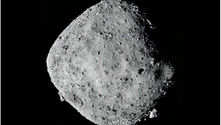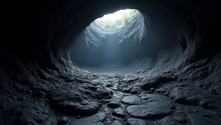top of page
News


Samples returned from Asteroid Bennu reveal a time capsule containing ingredients from before our solar system was even born
The OSIRIS-REx mission has successfully brought back pieces of the near-Earth asteroid Bennu, and the findings are extraordinary. More than just a simple space rock, Bennu is a composite object, assembled from the rubble of a much larger parent body. Its chemistry tells a story of materials gathered from the hot inner solar system, the icy outer reaches, and even from ancient stars that died long before our sun ignited.
Aug 281 min read


CHORD: The Ambitious Canadian Project Set to Change Astronomy
Building on the wild success of its predecessor, CHIME, the Canadian Hydrogen Observatory and Radio-transient Detector (CHORD) will be an order of magnitude more powerful. This homegrown telescope will leverage cutting-edge technology to detect thousands of Fast Radio Bursts (FRBs) in real-time, giving astronomers an unprecedented tool to map the cosmos and understand the enigmatic sources of these fleeting, powerful signals.
Aug 281 min read


NASA's Perseverance Rover Explores New Terrain at Soroya Ridge
After a mini-campaign studying wind-formed features at a location named Parnasset, Perseverance executed three successful drives to arrive at Soroya. This striking landform was first identified from orbit due to its bright appearance against the darker Martian terrain. Now on the ground, the science team is deploying the rover's full suite of instruments to analyze its composition and texture, seeking clues about Mars's ancient past.
Aug 281 min read


The Role of Izaña-2 in Ensuring a Safer Orbital Environment for Satellites
As the threat from space debris becomes a daily concern for satellite operators, the European Space Agency is developing innovative technologies to keep our orbits safe. At the Izaña station in Spain, ESA's Izaña-1 and Izaña-2 laser-ranging stations are testing a high-precision method to track debris, prevent collisions, and eventually, even nudge junk out of the way.
Aug 281 min read


How the Roman Space Telescope Will Transform Asteroid Defense
When NASA's Nancy Grace Roman Space Telescope launches, it won't just be peering into the distant universe. From its vantage point 1.5 million kilometers away, this powerful observatory will also serve as Earth's newest guardian, helping scientists track and understand asteroids and comets that could threaten our planet. What makes Roman so valuable is its ability to measure not just *where* an object is, but what it's made of and its exact size—critical data for any real pla
Aug 261 min read


How Apollo Missions Revealed the Moon's Mysterious Beginnings
You know, if you think about it, and trust me we're about to, the moon is kind of weird. Of all the terrestrial worlds of the solar system, we're the only one with a substantial natural satellite. Mercury and Venus have nothing. And while Mars technically has two moons, they're really just captured asteroids and don't really count. Sorry Phobos and Deimos, but that's the way it is.
Aug 261 min read


How Thermoelectric Generators Could Transform Lunar Energy Needs
As NASA's Artemis program aims to establish a long-term human presence on the Moon, one of the greatest challenges is finding a reliable power source. A recent study from the Republic of Korea explores how Thermoelectric Generators (TEGs) could be uniquely suited to the task, not just by surviving the Moon's harsh conditions, but by harnessing them.
Aug 261 min read


How TESS and Kepler Help Map Star Spots Across the Galaxy
When hunting for other worlds, astronomers have a problem: the stars those planets orbit are not perfect, uniform spheres of light. Like our own sun, they are complex, active, and covered in dark "star spots." A new method, `StarryStarryProcess`, uses the transits of exoplanets to map these spots, helping scientists untangle the light of the star from the light of the planet.
Aug 261 min read


Ireland’s First Satellite Achieves Breakthrough in Space Navigation
Ireland's first satellite, EIRSAT-1, has successfully completed its mission in low-Earth orbit. The CubeSat, which was launched in 2023, was designed, built, and operated by students and faculty at University College Dublin (UCD). After achieving all its scientific and technological goals, the satellite is expected to de-orbit within days, marking a proud and historic moment for the nation's growing space sector.
Aug 161 min read


How Climate Change is Reshaping Space Weather
Our modern society depends on thousands of satellites for navigation, communication, and security. One of their greatest natural threats is geomagnetic storms—massive eruptions from the sun that buffet Earth's upper atmosphere, increasing its density. This increased density creates drag, slowing satellites, changing their altitude, and shortening their operational lives. New research from NSF NCAR reveals that as carbon dioxide levels rise, this threat isn't going away—it's j
Aug 161 min read


The Role of Space Agriculture in Long-Duration Space Missions
When the Crew-11 astronauts launched to the International Space Station on August 1, 2025, they carried with them another chapter in space farming: the latest VEG-03 experiments. Growing plants in space provides essential nutrition for astronauts, as well as crucial psychological benefits that help maintain crew morale during long missions.
Aug 161 min read


Robotic Explorers Illuminate the Secrets of Lava Caves for Future Space Colonization
In the search for life—and for safe human bases—off-world, scientists are looking down. Deep underground caves known as lava tubes, found on both Mars and the Moon, could offer protection from the harsh space environment. But sending humans is currently unfeasible. The solution? Autonomous robots. To test this, scientists recently deployed a cooperative robot team in a lava cave on the Spanish island of Lanzarote.
Aug 161 min read
bottom of page


